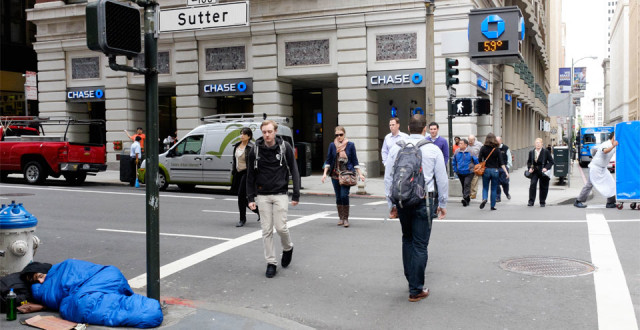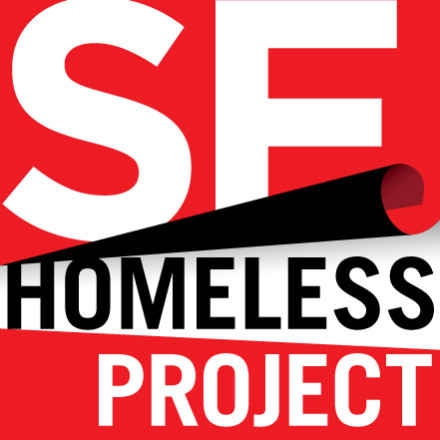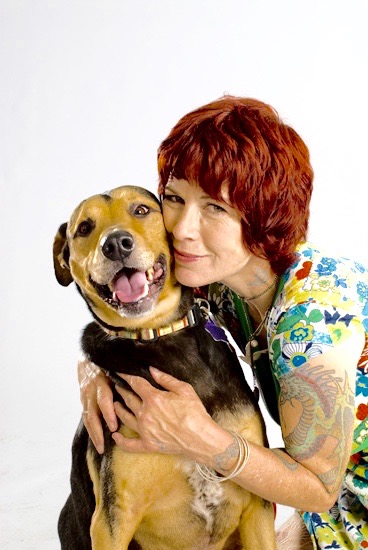

As I write this letter in my office on Market near Second Street, a “nut-case” is screaming his head off beneath my window … when I walk to my office each morning on Market between Sansome and Montgomery … I have to step over half-naked people and their body waste … Then we have a nearly naked man who “lives” on Market Street in front of See’s Candies at Sansome. Stretched across the sidewalk, pedestrians have to hold their noses and walk around him … When I need to go near Sixth and Market streets it becomes worse. Drug dealing in broad daylight. Hell on Earth … If this city survives this era, future generations will look back and be horrified at what these people have done to San Francisco.
— Excerpt from a letter to the San Francisco Business Times
A few months ago I came across a letter to the San Francisco Business Times. The author, an understandably frustrated San Francisco resident named Richard Kales, went on at length about the perils of working downtown with its throngs of drug addicted, mentally ill, and sometimes violent denizens. Kales, it appeared, was yet another recent transplant complaining about the city’s less fortunate citizens with that trademark lack of empathy. There have been quite a few. Take, for example, Justin Keller, a tech entrepreneur who made headlines last February after ranting on his personal blog that the homeless problem is the worst it has ever been in the three years he’s lived here. Keller was angry that the “riff raff” disrupted his parents’ visit from Santa Barbara and a trip to the movies with his girlfriend. “The wealthy working people have earned their right to live in the city. They went out, got an education, work hard, and earned it … I shouldn’t have to see the pain, struggle, and despair of homeless people to and from my way to work,” Keller opined.
As I made my way through the letter to the Business Times, the tone was markedly similar. Along with a mutual disdain for stepping over indigents, Kales was unhappy with the large number suffering from mental illness. The majority of the homeless are, he said, “individuals who want to live on someone else’s nickel” and the balance are “mentally ill and have no loony bin to be put in.” He also asserted that homeless advocates “turned a world-class city into a dump” and took umbrage with the district attorney for saying he didn’t believe San Franciscans wanted to prosecute people who didn’t have a place to stay. Yes, Kales said, he did want them prosecuted: “Anything to end this situation is fine with me.” It wasn’t until I saw the name of the district attorney — Terence Hallinan — that I realized this wasn’t a recent missive. In fact, it had been written in 2001. For those who have lived in San Francisco many years or many generations, the fact that the Kales and Keller letters, written 15 years apart, are nearly identical comes as no surprise. For newer residents, however, it may indeed come as a shock that the homeless problem didn’t start when they moved here.
FROM LACK OF EMPATHY TO KILLING WITH KINDNESS
Despite city lawmakers throwing millions of dollars at homelessness, nothing has worked. While residents and business owners grow angrier by the day over their declining quality of life and livelihood, homeless advocates often go to the other extreme, handing out shiny new tents and filing lawsuits against the city when it clears the resulting shantytowns (it violates their civil rights). These same people have also fought “tough love” solutions for years, including requiring the homeless to carry identification cards so their cases may be tracked (it violates their privacy) and giving them one-way bus tickets back to where they came from (another violation of their civil rights). But those working on the front lines say leaving the homeless on the streets is not only dangerous, it’s inhumane.
Alan Byard says in his four decades as a patrol special police officer, he’s noticed not only a dramatic increase in the homeless population but also in the number with psychiatric issues. “Many have serious mental health problems and some are so incoherent when I speak to them that they can’t comprehend or carry on a conversation when I ask them if they need city services,” Byard said. He estimates that 80 percent of the homeless he encounters have alcohol, drug, or mental health issues. “I think it is a cruel thing to leave them to fend for themselves when it is so obvious that they need help,” Byard said. “Sometimes you need to take an individual off the street, put them in a proper facility, and give them the care and help needed, even against their desires.”
That, of course, would mean bringing back psychiatric hospitals for the sickest homeless, which is a hard sell to the bleeding hearts handing out tents and to the politicians afraid of alienating their liberal constituents.
WE’VE BEEN HERE BEFORE
The vast majority of mental patients in the United States were released from hospitals and into communities under a policy now considered a total failure. Many in the psychiatric field during the 1950s and 1960s who helped craft that policy blame, in particular, the overreliance on tranquilizers as a cure-all. Politicians, pressured by the troubling image and financial strain of state-run hospitals, were equally culpable. In California, the number of patients reached a peak of 37,500 in 1959 under Governor Edmund G. Brown, fell to 22,000 in 1967 when Ronald Reagan was in office, and continued to fall during the first administration of Edmund G. Brown Jr.
The senior Brown later expressed regret. “They’ve gone far, too far, in letting people out,” he told The New York Times. Then-director of the National Institute of Mental Health Dr. Robert H. Felix, who was a major player in the shift
to community release, also expressed remorse. “Many of those patients who left the state hospitals never should have done so,” he said. “We psychiatrists saw too much of the old snake pit, saw too many people who shouldn’t have been there and we overreacted. The result is not what we intended, and perhaps we didn’t ask the questions that should have been asked when developing a new concept …”
Even though the epidemic of mental illness among the homeless is in our faces every day, we have clearly learned nothing from our mistakes. Of the five new hospitals under construction in San Francisco, not one has a psychiatric bed requirement, while at current hospitals those beds have declined precipitously. Until we realize that homelessness is not one-size-fits-all and that mental illness is the largest component of the problem, nothing will change. We also must learn to see the homeless as unique individuals. While some fit the stereotypes proffered by Kales and Keller, others are there because of circumstances far beyond their control — and a few have even walked in the very shoes that now step over them.
A DOODLE NAMED KRAMER
Several years ago while walking my pit bull, Skylar, in Buena Vista Park, I ran into an acquaintance with her Labradoodle and another doodle I didn’t recognize. “I was coming out of a movie and there were these kids trying to sell him because they needed to buy drugs,” she said. “They were so blatant about it, but I was scared for the dog and figured he might be stolen so I gave them twenty bucks.”
According to his tags, the dog’s name was Kramer. He was a goldendoodle — not your typical street dog — and the phone number on the tag was disconnected. At Animal Care and Control (ACC), we discovered that Kramer was microchipped with an address in Golden Gate Heights, but residents there said they weren’t missing a dog. I agreed to foster Kramer through Rocket Dog Rescue, and after one adoption event he had a wonderful new home. A week later I received a call from ACC saying they had solved the mystery: Kramer’s owner, a homeless man, had been badly beaten and, as my friend suspected, the dog was stolen. The man had been in the hospital but came to the shelter looking for Kramer as soon as he was released.
“He’s happy where he is,” I told the ACC officer. “I don’t want him returned to some homeless man.”
“His owner is not who you think,” the officer said. “He used to own that house listed on the microchip. He had a wife and a couple of kids. He worked in high tech. Then the dotcom bubble burst, and he lost everything — his wife, the kids, the house, the cars. Kramer is all he has left.” Now I understood why a goldendoodle was homeless — because his owner once had the fancy life to go along with the fancy dog. I reluctantly called Kramer’s new adopters, who immediately lawyered up and refused to surrender him. Just when it seemed a custody battle was eminent, Kramer’s owner was hospitalized again. Just a few days later he died from his injuries. “That poor man. So many people die on the streets. It’s no place for dogs or humans,” said Rocket Dog founder Pali Boucher, and she would know.

Born to a homeless, drug-addicted mother in San Francisco, Pali remembers playing on Ocean Beach as a toddler while her mom slept off another high. When Pali was 10, her mother died, leaving her to grow up alone on the streets. She was addicted to drugs, in and out of jail, and every one of her knuckles was broken fending off attackers. She also contracted HIV. But a visit to the San Francisco SPCA changed her life. Wandering the halls to escape the rain, she made friends with a bloodhound baying mournfully from his kennel. She found herself visiting him daily, and on one of those visits she discovered he was slated for euthanasia. Pali faked an address and adopted the bloodhound, naming him Lead Belly after the renowned blues musician. She almost lost Lead Belly on another trip to jail, and that’s when she decided things had to change. She asked for help, got sober, secured housing, and got Lead Belly back. Since founding Rocket Dog Rescue in 2001, Pali and a dedicated band of volunteers have saved thousands of dogs, and Pali has been featured on two Animal Planet television specials, was recognized for her work in the community by CNN Heroes, and received the Points of Light Award for outstanding volunteerism.
Before Lead Belly’s love set her on the right path, the “wealthy working people” likely stepped over Pali and witnessed her pain, struggle, and despair. But my experience with Kramer and getting to know Pali has made me see the nameless faces I pass every day in a much different light.
It also made me think about one of my mother’s favorite sayings: “There but for the grace of God go I.”
Perhaps when Keller’s startup isn’t the next Apple or Google and he has the luxury of moving back to Santa Barbara to live with his parents, he’ll think about that.
Coalition on Homelessness
The coalition is looking for donations of everything from money to bicycles to books. (cohsf.org/fun-ways-to-donate)
Episcopal Community Services
Thirty-year-old organization offering job training, counseling, education, and more to homeless people. (ecs-sf.org/getinvolved/volunteer.html)
HandUp
Direct giving that verifies and tracks donations. (handup.org)
Lava Mae
San Francisco-based organization uses buses to provide mobile showers and bathrooms to the homeless. (lavamae.org)
Miracle Messages
This San Francisco-based group makes videos of homeless people and uses them to reconnect the homeless with their families. (miraclemessages.org)
Project Homeless Connect
Puts homeless people in touch with services, such as housing information, dental care, mental health services, SSI benefits, legal advice, and more. (projecthomelessconnect.org/about/our-mission)
San Francisco 311
This app connects you with city services, and in the “other” section you can find out who to contact when you need to report someone in need of the city’s homeless services. (sf311.org/other-city-services)
St. Anthony’s
Providing food, clothing, and connections to the city’s poor and homeless. (stanthonysf.org)
St. Vincent de Paul Society of San Francisco
Every day, St. Vincent shelters, feeds, and supports hundreds of homeless, and it also offers health and personal services (shower, laundry, etc.).
(svdp-sf.org/what-we-do/msc-shelter)



